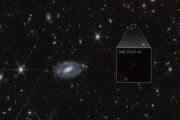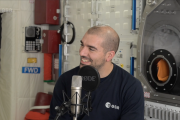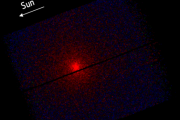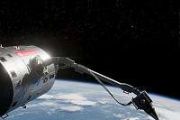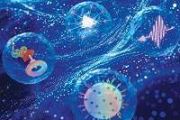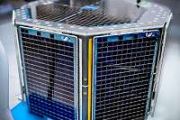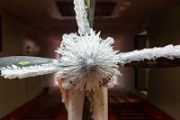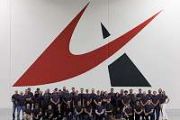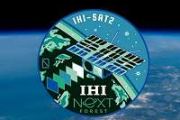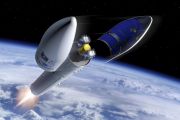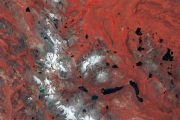
Copernical Team
SPIDER launches from Antarctica
 A team of scientists including physicist Johanna Nagy at Washington University in St. Louis successfully launched a balloon-borne experiment studying the early universe on Dec. 21. The instrument, called SPIDER, was carried aloft by a scientific balloon from its launch pad in Antarctica.
Nagy, an assistant professor of physics in Arts and Sciences, is one of a team of scientists who will u
A team of scientists including physicist Johanna Nagy at Washington University in St. Louis successfully launched a balloon-borne experiment studying the early universe on Dec. 21. The instrument, called SPIDER, was carried aloft by a scientific balloon from its launch pad in Antarctica.
Nagy, an assistant professor of physics in Arts and Sciences, is one of a team of scientists who will u Chinese commercial space company to launch stackable satellites
 China's private company GalaxySpace is accelerating the research and development of flat-panel stackable satellites, for rapid construction of a satellite internet constellation.
GalaxySpace said the design enables dozens of satellites to be stacked on top of each other like tablet personal computers and be launched at the same time on a single rocket. It can greatly improve the use effici
China's private company GalaxySpace is accelerating the research and development of flat-panel stackable satellites, for rapid construction of a satellite internet constellation.
GalaxySpace said the design enables dozens of satellites to be stacked on top of each other like tablet personal computers and be launched at the same time on a single rocket. It can greatly improve the use effici Researchers discover solar wind-derived water in lunar soils
 Due to its crucial importance in future space exploration, the abundance, distribution and origin of lunar surface water have received a lot of attention recently.
A joint research team from the National Space Science Center (NSSC) and the Institute of Geology and Geophysics (IGG), both affiliated with the Chinese Academy of Sciences (CAS), have discovered that the Chang'e-5 lunar soil gra
Due to its crucial importance in future space exploration, the abundance, distribution and origin of lunar surface water have received a lot of attention recently.
A joint research team from the National Space Science Center (NSSC) and the Institute of Geology and Geophysics (IGG), both affiliated with the Chinese Academy of Sciences (CAS), have discovered that the Chang'e-5 lunar soil gra Falcon 9 rocket launches 54 Starlink satellites
 A Falcon 9 rocket carrying 54 Starlink Internet satellites launched from Florida on Wednesday as part of a mission to begin populating a new orbital shell authorized by federal regulators.
The rocket launched from Cape Canaveral Space Force Station at 4:34 a.m. The mission was SpaceX's 60th of the year, nearly double the total from last year. One more launch is scheduled for the end of
A Falcon 9 rocket carrying 54 Starlink Internet satellites launched from Florida on Wednesday as part of a mission to begin populating a new orbital shell authorized by federal regulators.
The rocket launched from Cape Canaveral Space Force Station at 4:34 a.m. The mission was SpaceX's 60th of the year, nearly double the total from last year. One more launch is scheduled for the end of NASA, SpaceX to Study Hubble Telescope Reboost Possibility
 he non-exclusive SpaceX study regarding the possibilities of reboosting the Hubble Space Telescope is ongoing. On Thursday, Dec. 22, 2022, NASA issued a Request for Information to seek additional information about commercial capabilities available to reboost a satellite in orbit, using Hubble as a demonstration, at no cost to the government.
There are no plans at this time for NASA to cond
he non-exclusive SpaceX study regarding the possibilities of reboosting the Hubble Space Telescope is ongoing. On Thursday, Dec. 22, 2022, NASA issued a Request for Information to seek additional information about commercial capabilities available to reboost a satellite in orbit, using Hubble as a demonstration, at no cost to the government.
There are no plans at this time for NASA to cond The world's largest turbulence simulation unmasks the flow of energy in astrophysical plasmas
 Researchers have uncovered a previously hidden heating process that helps explain how the atmosphere that surrounds the Sun called the "solar corona" can be vastly hotter than the solar surface that emits it.
The discovery at the U.S. Department of Energy's (DOE) Princeton Plasma Physics Laboratory (PPPL) could improve tackling a range of astrophysical puzzles such as star formation, the o
Researchers have uncovered a previously hidden heating process that helps explain how the atmosphere that surrounds the Sun called the "solar corona" can be vastly hotter than the solar surface that emits it.
The discovery at the U.S. Department of Energy's (DOE) Princeton Plasma Physics Laboratory (PPPL) could improve tackling a range of astrophysical puzzles such as star formation, the o NASA, Alaska researchers to scan asteroid with radio waves
 Researchers are preparing for a potentially "catastrophic" close encounter with an asteroid in 2029 by scanning an asteroid with radio waves on Tuesday.
NASA is teaming with scientists from the University of Alaska Fairbanks' Geophysical Institute to send about 9.6 million radio waves to 2010 XC15, an asteroid that will pass by about twice the distance from Earth to the Moon.
The
Researchers are preparing for a potentially "catastrophic" close encounter with an asteroid in 2029 by scanning an asteroid with radio waves on Tuesday.
NASA is teaming with scientists from the University of Alaska Fairbanks' Geophysical Institute to send about 9.6 million radio waves to 2010 XC15, an asteroid that will pass by about twice the distance from Earth to the Moon.
The NASA, Russian space agency evaluate need for space station rescue mission
 NASA and the Russian space agency Roscosmos are evaluating if they will need to mount a rescue mission to the International Space Station after discovering a coolant leak from the Russian Soyuz spacecraft currently docked at the station.
The leaking spacecraft, designated Soyuz MS-22, carried U.S. astronaut Frank Rubio, along with cosmonauts Dmitri Petelin and Sergey Prokopyev to the In
NASA and the Russian space agency Roscosmos are evaluating if they will need to mount a rescue mission to the International Space Station after discovering a coolant leak from the Russian Soyuz spacecraft currently docked at the station.
The leaking spacecraft, designated Soyuz MS-22, carried U.S. astronaut Frank Rubio, along with cosmonauts Dmitri Petelin and Sergey Prokopyev to the In Musk says nearly 100 Starlinks 'active' in Iran
 Nearly 100 Starlink internet terminals are currently operating in Iran, SpaceX chief Elon Musk said Monday.
The tycoon had promised to bring the satellite internet network to the country in September as Iranian authorities imposed increasingly severe access restrictions, in a move activists called a campaign to limit information about protests that had broken out nationwide.
"Approachi
Nearly 100 Starlink internet terminals are currently operating in Iran, SpaceX chief Elon Musk said Monday.
The tycoon had promised to bring the satellite internet network to the country in September as Iranian authorities imposed increasingly severe access restrictions, in a move activists called a campaign to limit information about protests that had broken out nationwide.
"Approachi Space junk bill passes Senate unanimously
 U.S. Senator John Hickenlooper applauded Senate passage of his Orbital Sustainability (ORBITS) Act, a bipartisan bill to establish a first-of-its-kind demonstration program to reduce the amount of space junk in orbit. The bill passed the Senate unanimously.
"From satellite communications to rockets carrying humans into deep space, space debris is a massive threat to space operations," said
U.S. Senator John Hickenlooper applauded Senate passage of his Orbital Sustainability (ORBITS) Act, a bipartisan bill to establish a first-of-its-kind demonstration program to reduce the amount of space junk in orbit. The bill passed the Senate unanimously.
"From satellite communications to rockets carrying humans into deep space, space debris is a massive threat to space operations," said 





